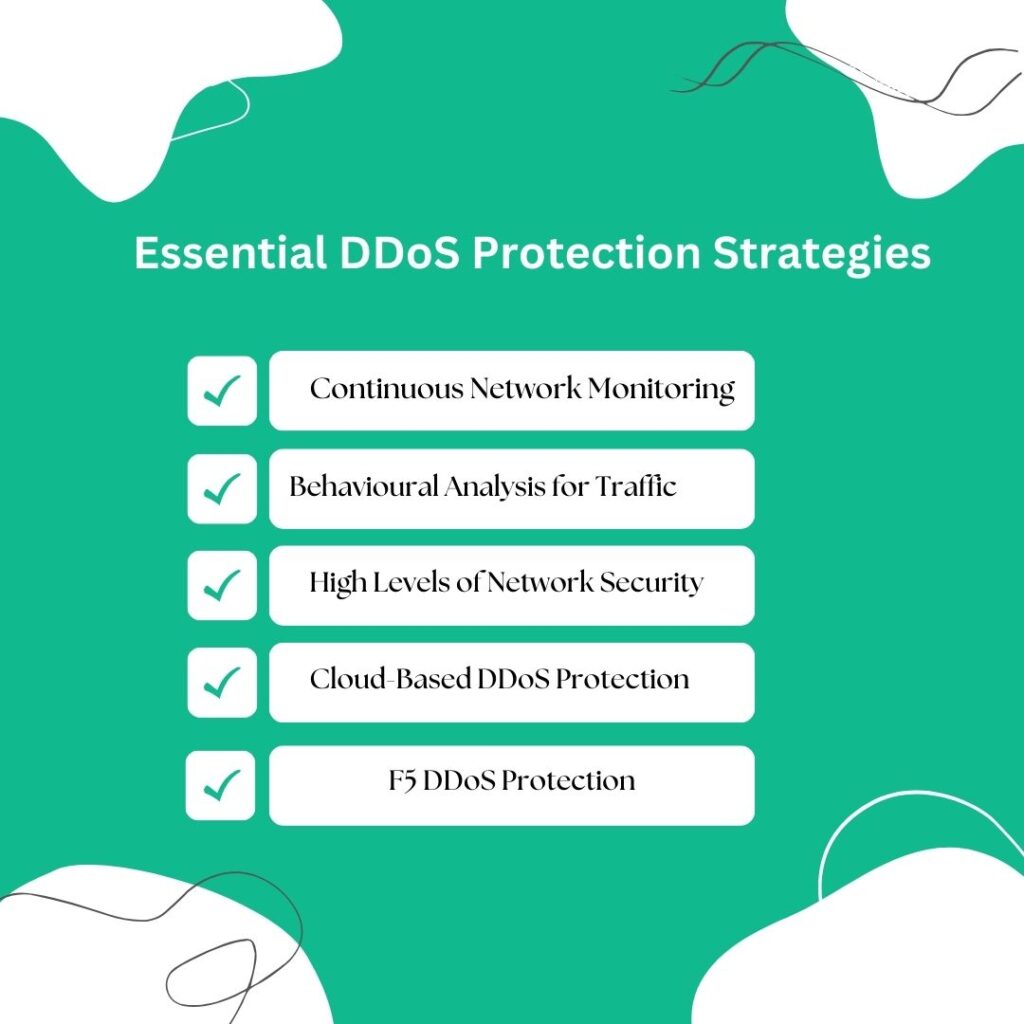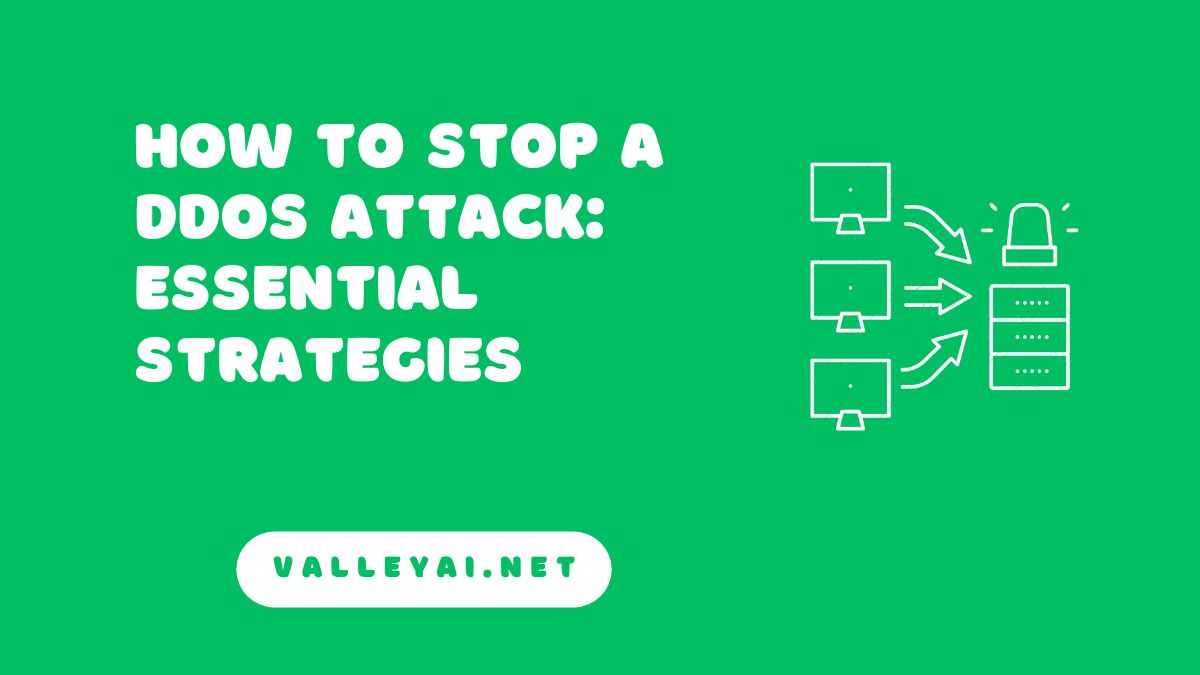In today’s digital landscape, businesses and websites are vulnerable to DDoS attacks that can cause significant damage to their online operations. A Distributed Denial of Service (DDoS) attack can disrupt a website’s normal functioning by overwhelming its server with requests from multiple sources. These attacks can be devastating when not handled properly. Understanding the nature of DDoS attacks is crucial in devising an effective protection strategy.
In this blog, we’ll give you expert tips on how to stop a DDoS attack. We will cover everything from identifying different types of DDoS attacks to implementing behavioral analysis and ensuring high levels of network security. We’ll also discuss the role of cloud-based DDoS protection strategies such as CloudFlare and F5, specific tactics for stopping internal, external router, server and website DDoS attacks, damage control after a DDoS attack and finally, preparing for future attacks.
Understanding the Nature of DDoS Attacks
DDoS attacks overwhelm networks, making them inaccessible to legitimate users. Attackers employ botnets to generate an enormous volume of traffic that surpasses server capacity. These attacks can target specific network resources like web servers or DNS servers. Volumetric attacks flood networks with traffic, consuming both bandwidth and server resources. Application layer attacks exploit vulnerabilities in web applications, depleting server resources. Understanding the nature of DDoS attacks is crucial for businesses of all sizes as they face the risk of these bad actors.
Identifying Different Types of DDoS Attacks
Identifying different types of DDoS attacks is crucial for effective DDoS mitigation.
- One common type is the SYN flood, which overwhelms a server with connection requests, depleting its resources rapidly.
- Another type is the UDP flood, where a network is flooded with User Datagram Protocol (UDP) traffic, leading to network congestion.
- Protocol attacks exploit vulnerabilities in network protocols, disrupting service availability.
- Application layer attacks specifically target web application servers, bombarding them with an overwhelming number of requests.
- DNS amplification attacks exploit open domain name system servers to generate a massive amount of traffic.
Recognizing Signs of a DDoS Attack
In order to detect a potential DDoS attack, keep an eye out for certain indicators. Unusually slow network response times might be a sign that a DDoS attack is underway. Multiple requests originating from a single IP address or specific locations can also serve as warning signs.
Additionally, be vigilant for sudden surges in traffic, especially if they follow specific patterns, as this could indicate a volumetric attack. Another red flag to watch out for is the website URL becoming inaccessible or displaying false error messages. Lastly, an increase in fake traffic or false data requests may be indicative of a malicious attack.
How to stop a DDOS Attack?
To stop a DDoS attack, there are several essential strategies to consider. These include utilizing a robust firewall, implementing traffic filtering and rate limiting measures, utilizing a content delivery network (CDN), and leveraging a DDoS protection service to monitor and mitigate attacks in real-time.
Essential DDoS Protection Strategies

Let us look at some ddos attack prevention tips. Continuous network monitoring is crucial in identifying signs of a DDoS attack in real-time. By continuously monitoring network traffic, businesses can detect abnormal patterns and take immediate action to mitigate the attack.
Implementing traffic rate limiting is another effective strategy to prevent network resources from being overwhelmed by a flood of malicious traffic. Web application firewalls play a key role in protecting against application layer attacks by filtering out malicious traffic and allowing only legitimate traffic to reach the servers.
Additionally, having a robust incident response plan in place ensures that businesses are well-prepared to handle and mitigate a DDoS attack effectively. Implementing best practices such as limiting connection requests further strengthens the defense against DDoS attacks.
Importance of Continuous Network Monitoring
Continuous network monitoring is crucial in the fight against DDoS attacks. By constantly monitoring the network, security teams can quickly detect and respond to any potential attacks. This type of monitoring allows for the identification of abnormal traffic patterns, which could be indicative of a DDoS attack. It also provides visibility into traffic patterns, enabling a proactive response to any attacks.
Real-time monitoring is especially important as it helps protect against new attack patterns and future attacks. Additionally, monitoring bandwidth usage allows for the identification of traffic spikes, a key indicator of a potential attack.
Implementing Behavioural Analysis for Traffic
Implementing behavioural analysis for traffic is an effective strategy in differentiating legitimate users from malicious traffic. By analysing traffic patterns, businesses can identify and block abnormal traffic, thus preventing a DDoS attack. Rate limiting based on user behaviour is another useful approach to prevent high traffic volume attacks.
Furthermore, behavioural analysis of traffic patterns enables the identification of botnet traffic, which is a key factor in DDoS attacks. To enhance protection against application layer attacks, utilizing network traffic anomaly detection tools is highly recommended.
Ensuring High Levels of Network Security
Regular security audits of network infrastructure are crucial to prevent vulnerabilities that can be exploited in a DDoS attack. Implementing a strong firewall is an effective measure to block malicious traffic and protect against a DDoS attack. It is essential to regularly patch network devices and servers to ensure security against known attack vectors.
Network segmentation is another valuable tactic, as it isolates critical resources, limiting the surface area of attack. Employing traffic filtering techniques like rate limiting helps to block malicious traffic at the network level.
Role of Cloud-Based DDoS Protection
Cloud-based DDoS protection services play a crucial role in mitigating and preventing DDoS attacks. These services provide scalable and distributed mitigation, allowing businesses of all sizes to effectively defend against such attacks. By leveraging the resources of cloud providers, organizations can absorb volumetric traffic, preventing network overload and ensuring the smooth functioning of their online services.
Additionally, cloud-based protection services protect against application layer attacks by blocking malicious traffic. They also enable businesses to block malicious traffic closer to the attack source and provide a new IP address, effectively mitigating the impact of a DDoS attack.
Advantages of Cloud-Based DDoS Protection
Cloud-based protection services offer rapid deployment, ensuring quick mitigation of attacks. The scalability of cloud services allows businesses to handle traffic spikes during a DDoS attack without disruptions. Cloud providers have a network of distributed data centers that enhance protection against attacks.
Real-time traffic monitoring in cloud services enables the detection and blocking of malicious traffic patterns effectively. Moreover, cloud-based protection services provide a cost-effective way to safeguard businesses of all sizes against DDoS attacks. By leveraging the key benefits of cloud-based DDoS protection, organizations can defend their entire network from bad actors and ensure the continuity of online services.
Using CloudFlare and F5 for DDoS Protection
CloudFlare and F5 are two reliable options for DDoS protection.
CloudFlare’s web application firewall effectively safeguards against application layer attacks. It also offers integrated L3-7 DDoS protection, enabling organizations to monitor, prevent, and mitigate attacks before they reach their targeted applications, networks, and infrastructure.
On the other hand, F5’s traffic rate limiting feature plays a crucial role in preventing network resources from being overwhelmed by malicious traffic.
Combining the services of CloudFlare and F5 provides a robust defense against various types of DDoS attacks, ensuring the security of online services for businesses of all sizes. This combination proves to be an effective strategy in mitigating the attacker’s ability to disrupt legitimate traffic and safeguard the entire network.
Stopping Specific DDoS Attacks
To protect your network from targeted DDoS attacks, it’s crucial to understand and prevent different types of attacks. Implementing best practices is essential for defending against volumetric attacks, which flood your network with a high volume of traffic. Rate limiting can help block malicious traffic and protect server resources.
Deploying web application firewalls adds an extra layer of defense against application layer attacks. Partnering with cloud providers enables you to mitigate distributed denial of service attacks effectively.
Tactics for Internal and External Router, Server and Website DDoS Attacks
Implementing a robust network infrastructure is crucial in preventing DDoS attacks. This includes the use of firewalls and load balancers to safeguard against different types of DDoS attacks. To detect and mitigate attacks in real-time, it is essential to utilize advanced tools and software that can effectively monitor network traffic.
Additionally, having a comprehensive plan in place, including a dedicated response team and backups, is vital for minimizing the impact of a successful DDoS attack. Collaboration with internet service providers (ISPs) and hosting companies further strengthens defense mechanisms against external attacks. Staying updated on the latest DDoS attack trends and techniques allows businesses of all sizes to better prepare for future attacks.
Methods to Stop External Router or Video Game System DDoS Attacks
To stop external router or video game system DDoS attacks, there are several effective methods you can utilize. Firstly, configure your network to block traffic from specific IP addresses that are known sources of attacks. This will prevent the malicious traffic from reaching your systems.
Additionally, implementing rate limiting mechanisms will help prevent server overload in the event of a DDoS attack, ensuring that your legitimate traffic can still flow smoothly. You can also employ web application firewalls to protect against application layer attacks, as well as utilize network traffic analysis tools to detect and block malicious traffic patterns.
Recovery and Damage Control after a DDoS Attack
After experiencing a DDoS attack, it is crucial to assess the extent of the damage caused. This assessment helps in planning an effective recovery strategy. It is also important to thoroughly analyze the incident response to identify any adjustments that need to be made in the remediation process. Collaborating with security teams is essential to prevent future attacks and protect against new attack patterns.
One of the key steps in recovery and damage control after a DDoS attack is implementing a mitigation plan. This plan helps in preventing future attacks and safeguarding server resources. Additionally, considering changing domain name system (DNS) servers can be an effective measure to prevent future attacks.
By following these measures, businesses of all sizes can recover from a DDoS attack and protect their online services.
Assessing DDoS Attack Damage
Evaluating the impact of a DDoS attack on network resources, services, and users is crucial in understanding the extent of the damage caused. By identifying system vulnerabilities exposed during the attack, businesses of all sizes can take steps to prevent future attacks and strengthen their security measures.
Assessing network bandwidth usage and analyzing server response time are effective ways to detect abnormal patterns that indicate an ongoing DDoS attack. Additionally, evaluating website URL response time allows organizations to identify potential DDoS attacks before they escalate. The best way to protect online services from the harm caused by bad actors is to assess and address the damage inflicted on the entire network.
Remediation Adjustments and Lessons Learned
Implementing security measures to prevent future attacks based on the lessons learned is crucial. By collaborating with security teams, system vulnerabilities exposed during the attack can be addressed effectively. Reviewing the incident response plan is essential to improve mitigation and response to future attacks. Conducting regular security audits helps identify areas of improvement in network protection against DDoS attacks.
Preparing for Future DDoS Attacks
Partnering with anti-DDoS vendors is a key strategy to enhance protection against future attacks. By leveraging the expertise and technology of these vendors, businesses of all sizes can effectively mitigate the impact of DDoS attacks. Implementing network security measures is another crucial step in reducing surface exposure to such attacks.
Analyzing network traffic patterns helps identify specific locations that are vulnerable to attacks, enabling proactive measures to be taken. By employing rate limiting techniques, businesses can block malicious traffic while ensuring that legitimate users have enough bandwidth.
The Role of Anti-DDoS Vendors in Future Attacks
Collaborating with anti-DDoS vendors is crucial to plan, prevent, and mitigate future attacks. By leveraging their services, businesses of all sizes can effectively protect against specific types of DDoS attacks, such as syn floods or UDP floods. Anti-DDoS vendors provide traffic analysis tools that enable the identification and blocking of malicious traffic, ensuring legitimate traffic flows smoothly. Real-time monitoring of server resources using their services helps in preventing ongoing attacks.
Additionally, working closely with vendors allows businesses to effectively block fake traffic, false error requests, and false data requests, mitigating the impact of future attacks.
Are You Ready to Face a DDoS Attack?
Evaluate your network security to assess preparedness against DDoS attacks. Identify potential attack vectors and address security gaps. Regularly conduct security audits to ensure network protection. Implement proactive measures against various attack types. Develop an incident response plan for minimizing damage. According to Cloudflare, ransom DDoS attacks increased by 60% in 2023.
Conclusion
In conclusion, stopping a DDoS attack requires a multi-layered approach that includes understanding the nature of DDoS attacks, implementing essential protection strategies, utilizing cloud-based DDoS protection, and knowing how to stop specific types of DDoS attacks. It is crucial to continuously monitor network traffic, analyze behavior patterns, and ensure high levels of network security. In case of an attack, assessing the damage, making necessary remediation adjustments, and learning from the experience are essential for recovery and future preparedness.
FAQs
Is it possible to stop a DDoS attack?
Yes, it is indeed possible to stop a DDoS attack. By implementing effective DDoS protection measures such as utilizing a content delivery network (CDN), firewalls, and intrusion prevention systems (IPS), the impact of an attack can be prevented or mitigated. It is crucial to have a well-defined response plan in place to effectively handle such attacks.
Does turning off the router stop a DDoS?
Turning off the router may provide temporary relief from a DDoS attack, but it is not a permanent solution. Since DDoS attacks can originate from multiple sources, simply turning off the router may not prevent all attacks. To effectively stop a DDoS attack, it is essential to identify and block the source. For more advanced measures, consult with a cybersecurity expert.
- Understanding the Landscape of Cloud Vulnerability Management - March 25, 2024
- Quality Assurance Strategies for Startups: Ensuring Software Reliability - March 5, 2024
- Working of NLP to Improve Copywriting in AI Paraphrasing Tool - February 28, 2024

